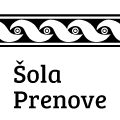Through the town of creative people
Find inspiration for your peace on an exciting walk among the town squares and town walls. Continue among interesting sculptures into the green nature.
Start at the Centre of the world
One of the oldest burgher houses on Slovenj Gradec’s Glavni trg square has for several years been bearing the inscription CENTRE OF THE WORLD – the world that fights for peace and humanity among people. The inscription emphasizes the town’s character of a messenger of peace. The former Town Hall (1) is now a centre of cultural life and the first stop for visitors. It is home to the Carinthian Regional Museum (2) and the Koroška Art Gallery (3). There is also a Tourist Information Centre (4) here.
(Recommended time for a stop: 10 minutes); (From this to the next point: 1 minute)
Continue to two churches
After seeing selected collections in the former town house, go past the sculpture dedicated to the local painter Jože Tisnikar (5), and head for the site that the statue of the Venetian horse (6) is directed at. When you cross Trg svobode square, which is often the venue for town events, stop on its other side next to the two churches. The bigger one from 1251, is the first church in the world, which is dedicated to St. Elisabeth (7). Among other valuables, there is also a window made in memory of Hugo Wolf, a famous composer born in Slovenj Gradec. The neighbouring Church of Holy Spirit (8), first mentioned in 1428, is a fine example of Gothic architecture. The path between the churches leads to the indicated course of the medieval walls with a moat.
(Recommended time for a stop: 25 minutes); (From this to the next point: 1 minute)
At the rectory of the first museologist
Return to Trg svobode square. On the left, you will notice the rectory (9) with statues of two important spiritual men. Jakob Soklič (1893 – 1972) is considered to be the first museologist of the area. The rectory was a real cultural centre of the town in his time. Franc Ksaver Meško (1874 – 1964) is an important Koroška writer who worked as a priest in Sela above Slovenj Gradec.
(From this to the next point: 4 minutes)
Among famous townspeople
At the end of Trg svobode square, turn left onto Glavni trg main square, where monuments to prominent townspeople are lined up. Memorial plaques on the facade of the Slovenj Gradec Hotel (10) indicate that Josef Potočnik, a military doctor and the father of the pioneer of space techniques Herman Potočnik Noordung, as well as the poet Ernst Goll were born in this house . A little further on, you will see the entrance to an interesting museum collection about the Štirje kovači ensemble (11), a legendary music band that has been operating continuously for more than 60 years.
(Recommended time for a stop: 30 minutes); (From this to the next point: 1 minute)
To the famous composer of solo
Across the street is a house of different music. In one of the most beautiful Baroque houses in the town centre, built at the turn of the 17th and 18th centuries, Hugo Wolf, a cosmopolitan composer of late romantic solo song was born. On the inside of the courtyard, on the first floor, there is a wooden balcony called gank. Tombstones and a memorial plaque, which was once on the front of the house, are built into the wall. Here is the International Hugo Wolf Information and Documentation Centre (12).The memorial exhibition displays Wolf’s life and work.
(Recommended time for a stop: 10 minutes, exhibition: 30 minutes); (From this to the next point: 1 minute)
Among fountains of life and honey
Head back to the town core on the left side of the Main Square. The entrance to Honey Heaven Perger 1757 (14) is between two of the three Fountain of Life sculptures (13), created by Mirko Bratuša. The ninth generation of the Perger family preserves the remarkable heritage of gingerbread, lectar and candle making. Enter the store.
A Tip: At this shop of lovely honey goodies, you can also arrange a guided tour of their gingerbread gallery and museum, which is outside the centre.
(Recommended time for a stop: 15 minutes); (From this to the next point: 2 minutes)
From the old pharmacy to a different bookstore
When you notice the pharmacy sign, look at the 17th-century house. The pharmacy (15) has been operating in this building since 1779. Turn left into the underpass, which houses an exhibition of former pharmacy props. The path leads further on to the atrium of Andeški hram (16) with glass sculptures by Matijaž Gostečnik on display. Andeški hram is home to a multi-generation centre and Meškova bukvarna, where a book lovers’ society organizes book exchanges. Here is also the first Koroška escape room (17), where you can discover the secrets of the town in tense adventure games by prior arrangement.
(Recommended time for a stop: 10 minutes); (From this to the next point: 2 minutes)
Along the high wallst to the town manor
Go through the second underpass and head across Cankarjeva ulica street. The steps lead to the medieval town walls (18) – the highest preserved walls in Slovenia. In some places, they are four meters high. Here is a beautiful view of the Church of St. Pancras with the Stations of the Cross and Uršlja gora in the background.
From the walls, return to the parking lot. To the left you see the towers of the Rotenturn Manor (19). Step into its atrium. The arcaded courtyard of the manor, which served to defend the town against the invading Turks in the 15th century, is the most beautiful venue for town events.
(Recommended time for a stop: 15 minutes); (From this to the next point: 1 minute)
Mastery. Freedom. Peace.
When you exit the atrium, turn left. At the junction head right into Šolska ulica street where you will find Levovnik Cobbler’s Workshop (20). See the museum collection in one of the oldest preserved shoemaking workshops in Slovenia. At the end of Šolska ulica street, head back to Glavni trg square where you will see the third Fountain of Life sculpture (13) on the left side. Cross the road and continue along the Main Square in the same direction to the Freedom Monument (21). Walk on to the junction where you will see the statue of Mahatma Gandhi (22) in the park opposite the post office. From here, return to the starting point of your tour along the Main Square.
A Tip: At the entrances to the town centre, there are still renovated restaurants with rich culinary offer. In selected bars, treat yourself to the town’s popular Wolf coffee, roasted according to a special recipe and served with plenty of cream.
Suggestions for a hike
To Rahtelov vrh for views
The 4-kilometer circular forest – educational trail with the Forest of my town theme brings you to the top of the peak with beautiful views of the town and the upper part of the Mislinja Valley with the surrounding mountains. The trail starts opposite Murko inn, on Francetova cesta street in Slovenj Gradec, and leads through the forests called Gmajne. You get to know various tree species along the way. You can also walk to the starting point of the trail. Go past the Rotenturn Manor, continue across the bridge over the Suhodolnica River and turn right onto the cycling – walking path. After a good kilometre, the starting point of the trail awaits you on the left.
1. Former town house
The building, first mentioned as early as 1612, has been used for a variety of purposes throughout history. It was a prison and timber storage. It was the seat of the district board, the county seat and the National Office of the Kingdom of Yugoslavia. There were also apartments here, the municipality, the district court, a tax office, headquarters of the German authorities and even the UDBA (the state security administration) office. Today, the building houses a museum and a gallery. The inscription Centre of the World is a work of art with which the group Fokus opened the issues of war and peace in 2016.
Glavni trg 24
2. Carinthian Regional Museum
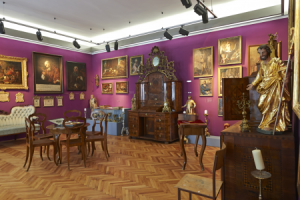
The Carinthian Regional Museum invites you to see its permanent collections and temporary exhibitions. The permanent “World. Europe. Us” exhibition, which is also adapted for visually impaired visitors, presents a collection of Roman stone monuments and three important Roman settlements from the Koroško area. The museum also displays an extensive collection of the priest Jakob Soklič with more than 1,800 objects from the fields of archaeology, ethnology, cultural history, fine arts and non-European cultures. The personal belongings of the priest, writer and poet Franc Ksaver Meško can be seen in his memorial room, whereas Tretjak’s African collection takes us to another continent.
Glavni trg 24, T: 02 62 12 520
3. Carinthian Gallery of Fine Arts
The gallery, which already has more than three thousand works in its collection, operates as a museum of visual art. Since its founding in 1957, it has organized international exhibitions, emphasizing the values of humanism and solidarity. The activities of the gallery co-create the identity of the town – the messenger of peace. Four major international exhibitions (1966, 1975, 1979 and 1985) were held under the auspices of the United Nations.
Glavni trg 24,T: 02 882 21 31
4. Slovenj Gradec Tourist Information Centre
The centre in the former town hall provides tourist information about the town, the Koroška region and Slovenia. There are also tourist brochures, souvenirs, postcards, and products of local arts and crafts available.
Glavni trg 24, T: 02 88 12 116
5. Hommage to Tisnikar sculpture
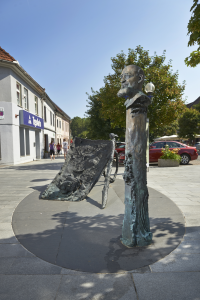
The point of the Hommage to the Slovenj Gradec painter Jože Tisnikar (1928–1998) sculpture, which in a truncated sense could be said with words: To the painter Jože Tisnikar, in honor and memory, is much deeper than the naming of the monument itself. The author of the sculpture, the sculptor Mirsad Begić, was also carefully chosen. He created a new work of art by combining “mythology”. The two-part sculpture, consisting of a chariot and a pillar with a portrait bust, is facing the entrance to the Carinthian Gallery of Fine Arts, beckoning you to enter.
In front of the Glavni trg 24 building
6. Statue of the Venetian horse
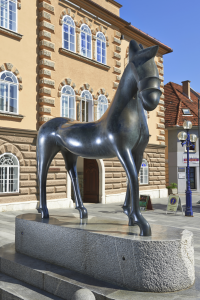
The statue made by Oskar Kogoj, which overlooks Trg svobode square and the Church of St. Elisabeth, was donated to the town in 1992. The image of the Venetian horse is one of the most distinctive images from the Early Iron Age. For the Veneti, he was almost a divine being, often depicted on situlae. The stylized image is supposed to illustrate their spiritual nature. Kogoj’s depiction of a horse in larger-than-life size can be found in several locations – including in front of the United Nations Palace in Geneva.
In front of the Glavni trg 24 building
7. The Church of st. Elisabeth
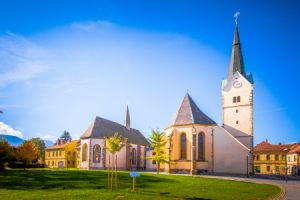
The first church in the world dedicated to St. Elisabeth is the oldest building in Slovenj Gradec. Count Berthold V of Andechs had it built in 1251 and dedicated it to his niece Elisabeth of Thuringia, a Hungarian princess, and the patron saint of the poor and beggars. The church has Baroque furnishings inside. The main altar, the work of Janez Jakob Schoy, is considered one of the greatest achievements of Baroque altar design in Slovenia. The painting of St. Elisabeth was made by Franc Mihael Strauss. There is also a picture window, which was commissioned by Katarina Wolf, Hugo Wolf’s mother, to honour the memory of her son.
Vorančev trg 7
8. The Church of the Holy Spirit
The Hospital Church, first mentioned in 1428, is a fine example of pristine Gothic architecture. The interior is decorated with Baroque equipment. The greatest attraction of the church are frescoes by Andrej Otting, depicting 27 scenes from the Passion Play. The church was also a meeting place of Slovenj Gradec Protestants. You can arrange a tour at the Tourist Information Centre.
Vorančev trg 6
9. Rectory
For more than 70 years, the house, built in 1884, housed the interesting Soklič Museum, which was relocated to the Carinthian Regional Museum. In front of the house is a monument to Jakob Soklič, a priest and the first museologist, who opened his collection of antiquities to the public in 1937. He worked as a guardian of movable cultural heritage for more than 40 years. Next to his statue is the statue of the writer Franc Ksaver Meško, who left Soklič a library with more than six thousand books.
Trg svobode 5
Hotel Slovenj Gradec
The Potočnik family owned the building of the town hotel in the 19th century. A memorial plaque announces that Josef Potočnik (1841 – 1894) was born here. He had an interesting military medical career after completing his medical studies at the University of Graz. His son, Herman Potočnik Noordung (1892 – 1929), was a famous rocket engineer and the pioneer of cosmonautics and space flight. The neoromantic poet Ernst Goll (1887 – 1912) was born in the same house. He described the Slovenian landscape in his works. He is buried in the family tomb in Slovenj Gradec.
Glavni trg 43, T: 02 883 98 50
11. Štirje kovači museum collection
“Where does the time fly” is the title of the legendary waltz, proclaimed to be the melody of the century. It is also the title of the exhibition, which presents the most important milestones in the development of the Štirje kovači ensemble from 1954 to today. It includes photographs, posters, sound carriers, music sheets and books, awards and recognition awards. The ensemble presented Slovenian folk music in America and Japan with his recognizable style.
Ozka ulica 1, Koroški pokrajinski muzej, T: 02 62 12 545
12. Hugo Wolf's birth house
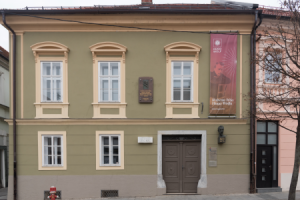
Hugo Wolf (1860 – 1903) was a composer who created more than 300 songs. In addition to solo songs, he also composed church music, works for orchestra and chamber music. A memorial exhibition devoted to Wolf’s life can be seen in his living environment from the end the 19th century. The house is also home to Documentation Centre, which is an international hub for many Hugo Wolf Societies around the world. There is also a library with a reading room, a small audio – video hall and a smaller concert hall. The Slovenj Gradec Hugo Wolf Society takes care of promotion and execution of traditional events.
Glavni trg 40, T: 02 62 12 520
Fountain of life
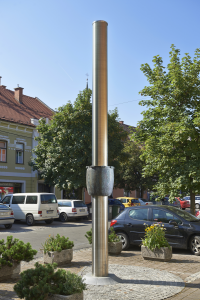
Fountains of Life – Fons Vitae, mark the main square. The artwork includes three sculptures created by academic sculptor Mirko Bratuša. The spring in front of house no. 36 illustrates the humanistic primordial cause of human existence. The Walk in front of house no. 30 symbolically depicts reflections and trials. The Obelisk in front of house no. 12 symbolizes a beacon and hope.
In front of the buildings on 36, 30 and 12 Glavni trg.
14. Honey heaven Perger 1757
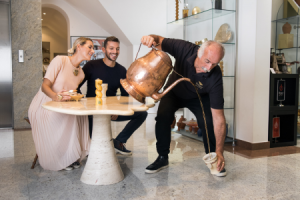
Masters of honey, gingerbread and candle making have already hosted the Dalai Lama, Luciano Pavarotti and more than a hundred thousand visitors from all over the world. Numerous awards testify to the quality and originality of their products, which are classified as Slovenian cultural heritage. You can choose from gingerbread hearts, gingerbread, candies, lollipops, honey drinks and other products in the shop.
Glavni trg 34, T: 02 88 41 496
15. Pharmacy
The oldest pharmacy in Koroška has been operating in the same building for centuries. The preserved interior details show that the building is probably from the 17th century. According to oral tradition, a mint once operated in this place. A special feature of the house was once a fountain in the basement.
Glavni trg 28
16. Andeški hram
The atrium and rooms of the restored Andeški hram provide a variety of experiences. In addition to used book treasures, Meškova bukvarna offers various events. The multigenerational centre provides knowledge transfer and active learning at all stages of life. The Koroška Handicraft Centre connects masters of various local crafts here.
Glavni trg 28 a
17. Enigmarium escape room
In the first escape room in Koroška, you are searching for Elizabeth’s treasure in an original game. Elisabeth supposedly received a crown, a luxurious dress and jewels from God himself. Where did she hide them? Discover the way to this hidden treasure. If you prefer outdoor experience, choose a tense adventure game around the old town. In the game, you try to explore the message of a mysterious locked book related to a former mint. Announce your arrival and reserve your experience.
Spotur Slovenj Gradec, Glavni trg 28 a, phone: 02 88 12 115
18. Medieval town wall
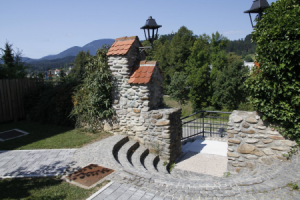
In the Middle Ages, Slovenj Gradec had a wall with a moat and several towers. It was probably built at the beginning of the 14th century. At that time, it was also regularly maintained and filled with water if necessary. The town also had two fortified gates. In the 16th century, the circumferential wall of the castle complex was added. Climb to the walls and enjoy the view of the St. Pancras Church, which the locals still call a castle, as today’s church has the design of the oldest castle in Slovenia.
behind the buildings in Cankarjeva ulica
19. Rotenturn manor
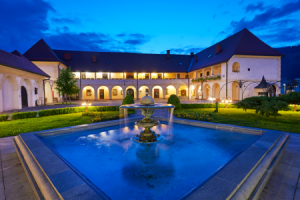
Today’s manor stands on the site of a defensive tower, first mentioned in 1361. It was rebuilt into a manor in 1494. It got its current appearance with an arcaded courtyard in the middle of the 18th century. A local Slovene folk school operated in it. Since the renovations in the 1980s, when the manor got its present appearance, it has been the seat of the Municipality of Slovenj Gradec.
Glavni trg 24
20. Levovnik cobbler’s workshop museum collection
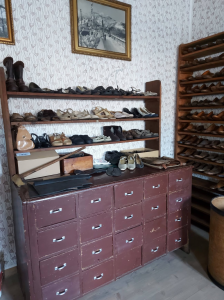
The museum collection with original shoemaking tools and accessories is on display in the workshop of the well-known Slovenj Gradec shoemaking family Levovnik, where more than 200 apprentices have learned shoemaking. The oldest exhibit dates from 1925. The workshop custom-made a variety of shoes, including special ones, such as forestry footwear with a protective cap according to their own patent.
Šolska ulica 3
21. Freedom monument
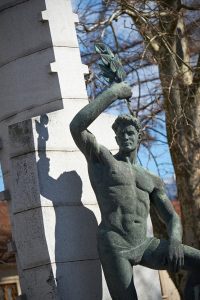
The monument, erected to honour the memory of freedom fighters in the Second World War, is the work of Stane Keržič ( 1918–1969), a representative of sculpture between socialist realism and conceptualism.
in front of the Vila Pohorje Hotel, Francetova cesta 2
22. Mahatma Gandhi statue
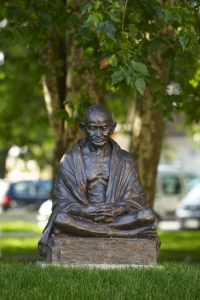
The statue of the leader Mahatma Gandhi (1869 – 1948), known for his non-violent attitude as a form of revolution, was donated to Slovenj Gradec, a town committed to the pursuit of peace, in 2010 by the Indian Embassy in Slovenia. The author of the statue, Ram V. Sutar, is one of the most eminent contemporary Indian sculptors. His depiction of Gandhi has been donated by the Government of the Republic of India to several countries around the world.
park at the intersection of Glavni trg and Pohorska cesta
- 11. Former town house
- 22. Carinthian Regional Museum
- 33. Carinthian Gallery of Fine Arts
- 44. Slovenj Gradec Tourist Information Centre
- 55. Hommage to Tisnikar sculpture
- 66. Statue of the Venetian horse
- 77. The Church of st. Elisabeth
- 88. The Church of the Holy Spirit
- 99. Rectory
- 10Hotel Slovenj Gradec
- 1111. Štirje kovači museum collection
- 1212. Hugo Wolf's birth house
- 13Fountain of life
- 1414. Honey heaven Perger 1757
- 1515. Pharmacy
- 1616. Andeški hram
- 1717. Enigmarium escape room
- 1818. Medieval town wall
- 1919. Rotenturn manor
- 2020. Levovnik cobbler’s workshop museum collection
- 2121. Freedom monument
- 2222. Mahatma Gandhi statue




